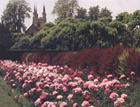Penshurst Place Peonies
Kathryn Bradley Hole celebrates the 'sumptous colouring and noble form', as well as the powerful scent, of the peony.


June 15, 2006
Earlier this week, I drove through Kentish woods of lovely coppiced chestnuts and hazels to join a lunch party at Penshurst Place, to celebrate the flowering of the peonies. All credit to Lord and Lady de l'Isle, who got the date spot on for the event. Too warm a spring brings the peonies on early; a very dry May can leave them parched and underperforming. As it turned out, the fortnight or so of rain that came mid-May (yes, the showers that washed out much of the Chelsea Flower Show), fattened the peonies' buds magnificently. This year's flowering is the best the de l'Isles can remember.
Penshurst's peonies are certainly something to be cheered. The gardens are among the few in this country with a substantial area devoted to these flowers in the extravagant spirit of the belle epoque. 'A field of paeonies in early summer, when a delightful burden almost weighs down the stems, is a rare picture,' declared Country Life in 1898, 'and if we do not want acres of plants, we do at least desire great groups upon the outskirts of the lawn, in the border, or by the drive, groups to make the true artist pause in admiration of their sumptuous colouring and noble form.'
Seeing the Penshurst peonies at full pelt (they run in their own dedicated border for 100 yards beside the orchard) made me think that, had such a border been in Claude Monet's garden, he would have been outdoors frantically painting them in different lights from dawn to dusk producing a series of peony canvases to compare with his waterlilies, or the façades of Rouen Cathedral. As it was, I found myself doing the 21st-century equivalent, obsessively photographing them from every angle, in close up and the long view.
Photographs do not capture their scent, however, which is powerful when peonies are planted en masse. Some have fragrance near to that of an old rose; in others, the scent is fugitive, or with a hint of grapefruit skins that tempers any sweetness. Certainly, Penshurst's mixture a carefully blended paintbox of lashings of Barbara Cartland pink, deep cerise cultivars and a scattering of shell pink with a dash of cream looks livelier than borders where only one or two varieties are used.
Habitually, the gardeners at Penshurst stake the re-emerging peonies in early spring with twiggy stems of hazel; this year, they tried bamboo for a change, but found the canes too obtrusive, so I was glad to hear that next year will see a return to the hazel tradition.
Dead-heading is one of the most important things to do at this time of year. It keeps plants flowering longer (preventing them diverting energy into making seeds), and suggests that everything is spruce and well cared for. Rosemary Verey used to say that dead-heading was the horticultural equivalent of combing one's hair, which I have always thought a very apt comparison. Few plants look good with dreadlocks (Amaranthus caudatus is an exception, of course). Dead-heading can also be sociable; one summer, I met a gathering of garden volunteers at Crathes Castle, all women, working their way through the rose beds, relishing a gossip as they tweaked and snipped.
Sign up for the Country Life Newsletter
Exquisite houses, the beauty of Nature, and how to get the most from your life, straight to your inbox.
What is the ideal time for this enjoyable chore? Well, early morning for birdsong accompaniment; during the day to top up a suntan; or as evening approaches, for scent and midsummer's luminous twilight.Visit www.penshurstplace.com or telephone 01892 870307. Herbaceous peonies are available from Kelways of Somerset (01459 250521) or visitwww.kelways.co.uk
This article first appeared in COUNTRY LIFE magazine on June 15, 2006
Country Life is unlike any other magazine: the only glossy weekly on the newsstand and the only magazine that has been guest-edited by HRH The King not once, but twice. It is a celebration of modern rural life and all its diverse joys and pleasures — that was first published in Queen Victoria's Diamond Jubilee year. Our eclectic mixture of witty and informative content — from the most up-to-date property news and commentary and a coveted glimpse inside some of the UK's best houses and gardens, to gardening, the arts and interior design, written by experts in their field — still cannot be found in print or online, anywhere else.
-
 Vertigo at Victoria Falls, a sunset surrounded by lions and swimming in the Nile: A journey from Cape Town to Cairo
Vertigo at Victoria Falls, a sunset surrounded by lions and swimming in the Nile: A journey from Cape Town to CairoWhy do we travel and who inspires us to do so? Chris Wallace went in search of answers on his own epic journey the length of Africa.
By Christopher Wallace
-
 A gorgeous Scottish cottage with contemporary interiors on the bonny banks of the River Tay
A gorgeous Scottish cottage with contemporary interiors on the bonny banks of the River TayCarnliath on the edge of Strathtay is a delightful family home set in sensational scenery.
By James Fisher